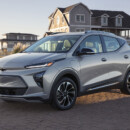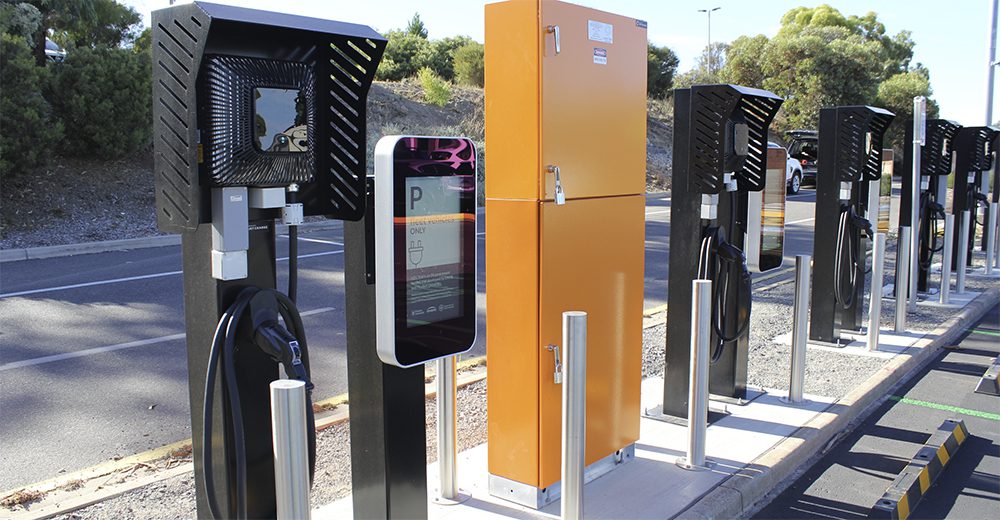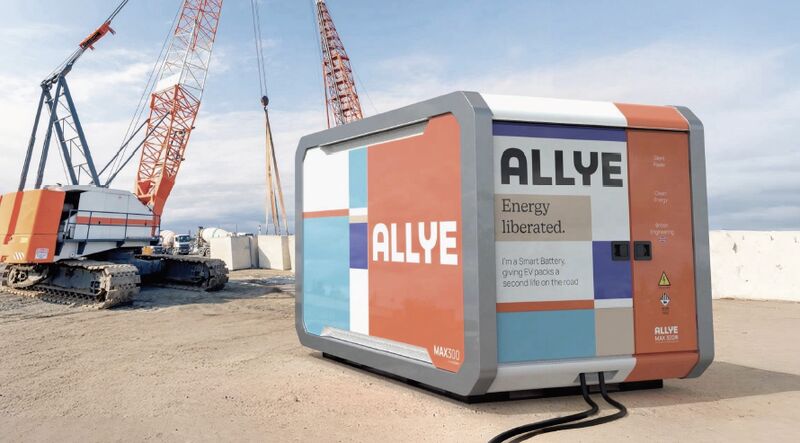For 2022, the Chevrolet Bolt lineup will expand from one to two models, with a new, so-called SUV version added alongside the original hatchback. Importantly, the Bolt siblings will take on a new role as the most affordable entries in a lineup of Chevrolet electric vehicles expected to grow significantly by 2025.
Chevy dubs its new second Bolt the EUV, or “Electric Utility Vehicle.” It’s a taller, longer, and blockier design that shares no body panels with the smaller Bolt EV. It does, however, share that car’s powertrain, carried over from a 2020 update that boosted the smaller Bolt’s range to an EPA-rated 259 miles. The company estimates the new Bolt EUV will come in at 250 miles.
The biggest news for the Bolt range may be its pricing. The 2022 Bolt EV starts at $31,995, down a whopping $4,500 from the 2021 edition. The larger Bolt EUV will start at $33,995, though limited numbers of a well-equipped Launch Edition with special badging are priced at $43,495. All prices include a mandatory destination charge.
GM vehicles are no longer eligible for a $7,500 federal income-tax credit for the purchase of an EV, but both cars remain eligible for various state, local, and corporate incentives, including purchase rebates of $2,500 in California and $2,000 in New York. The Biden Administration has said it intends to expand the pool of EV tax credits; if that happens, the effective post-incentive cost of a 2022 Bolt could come in under $25,000 for some buyers.
More rear-seat room, Super Cruise optional
Compared to its older sibling, the new EUV Bolt is 6.3 inches longer, almost 3 inches of that in the wheelbase, and a fraction of an inch taller and wider. The added room goes almost entirely into the rear seat, which has 3 inches more legroom than the Bolt EV. It’s 90 pounds heavier, but cargo capacity is almost identical to that of the smaller Bolt.
The new Bolt EUV will be the first GM car outside the Cadillac brand to offer Super Cruise, the hands-off driving assist system that adds automated steering to adaptive cruise control—as long as the driver’s eyes remain on the road ahead—on “compatible roads” that have already been mapped for the system. It won’t, however, offer the upgraded Super Cruise that allows automated lane changes; that requires a new electrical architecture GM is just rolling out on its newest Cadillacs. It’s not found in either Bolt.
The EUV will also offer an optional sunroof, one of the most frequent requests by existing Bolt owners, Chevy says. It also adds an optional built-in navigation system the older Bolt didn’t offer.
Is it really an SUV? The National Highway Traffic Safety Administration defines the Bolt EUV as a passenger car, because it doesn’t have the required ground clearance or available all-wheel drive that would make it a light-duty truck. But Jesse Ortega, executive chief engineer for the Bolt range, said Chevy doesn’t “buy into the notion that all-wheel drive is required to be called an SUV.” That may be news to shoppers who live in places where it snows—as roughly 70 percent of Americans do.
Ortega pointed out the EUV’s rear seats fold down to provide substantial load space. He didn’t add that those on the Bolt EV hatchback do the same thing, and provide equivalent cargo volume. Apparently squared-off styling is all that’s required to turn a hatchback into a “utility vehicle.” Frankly, to us, the Bolt EUV seems roughly akin to the Prius V, the longer wagon version of Toyota’s hybrid hatchback.
Bolt EV gets new interior, bigger screen
After its 2020 battery upgrade, the original Bolt EV hatchback was to have been lightly restyled for 2021. That was pushed out to 2022 as GM grappled with the implications of the global Covid pandemic on its sales, staffing, and other EV projects.
Owners of the 100,000 Bolt EVs sold globally to date are a vociferous lot, and they made their desires clear to the Chevy project team. They wanted new and more comfortable seats, a nicer and more premium-feeling interior, better displays and infotainment, and more active-safety features. (The rear-seat space they also wanted showed up in the new Bolt EUV instead, along with that sunroof.)
The new interior includes more soft-touch plastic surfaces, and a 10.2-inch center touchscreen display. The shift lever has been replaced by push-and-pull buttons, and there’s now a one-pedal driving button whose setting is retained when the car is turned off.
All 2022 Bolts are capable of Level 2 charging at up to 11 kW, roughly a 50-percent boost, from charging stations that can deliver it. A portable charging cord with pigtails for 120-Volt and 240-Volt sockets is standard with the new Bolt EUV, optional on the less expensive Bolt EV.
Both cars will arrive in showrooms early this summer.
Charging vs pricing
In 2017, only Tesla offered fast charging above the 50 kW level found in every other EV on the market. That’s one of the things that’s changed fastest over the last five years. GM has said its Ultium battery architecture and vehicle platforms will permit charging at rates of 125 to 350 kW, now respectively the standards for mass-market and premium EVs.
The Bolts, however, do not use Ultium components, which will first arrive on the market in the 2022 GMC Hummer EV toward the end of this year. Their older battery architecture is limited to fast charging that tops out around 55 kW, meaning 100 miles can be added to a largely depleted Bolt battery in roughly 30 minutes at best.
Mass-market electric compact crossovers like the Volkswagen ID.4 and Nissan Ariya that will go on sale this year can charge at rates up to 125 to 150 kW. Tesla charging speeds, meanwhile, have risen from up to 90 kW in 2012 to up to 250 kW today. That makes the Bolts simply uncompetitive for road trips, and Bolt engineers clearly made a conscious decision not to exert the effort to change that.
GM is well aware of the deficiency, even though Bolt executives defended the charging rates by citing data showing that 80 to 90 percent of Bolt miles are covered by Level 2 charging at home or at work. That’s undoubtedly true, but it’s hardly a justification for launching a pair of vehicles whose maximum charging rate is simply uncompetitive.
In fact, it’s likely because Bolt “fast” charging is so slow that Bolt owners aren’t taking many road trips. Or as one Bolt-owning journalist said on the media preview call, “A Bolt EV road trip is drive for 3 hours, charge for an hour and a half, then drive for 3 more hours, charge some more …”
When it hit showrooms in December 2016, the Chevrolet Bolt EV was the most advanced non-Tesla electric car on the market. With 238 miles of range between recharges, it doubled the distance an EV driver could cover compared to the Nissan Leaf, Volkswagen e-Golf, and other compact electric hatchbacks then on sale. Buyers waited months for delivery.
But “EV time” moves fast. And GM’s strategy for electric cars has grown far broader and more ambitious since then. It says it will launch 30 new EVs globally by 2025, and sell two-thirds of them in North America. The two Bolts aside, all will be based on the new lower-cost Ultium architecture, for which it is building a joint-venture cell plant in Ohio with longtime battery partner LG Chem.
Hot ticket to price leader in 5 years
During most of 2021, though, the Bolts remain GM’s sole electric entries. Going forward, lower prices for 2022 can compensate for a multitude of sins. Bolt executives said added volume from the addition of the EUV would boost overall sales to permit economies of scale for component purchases, but it remains unclear—and Chevy doesn’t comment on—whether the Bolt lineup breaks even.
Instead, the 2022 price cuts likely stem from the yawning gap between list price and “average transaction price” in recent years. Chevy has had to offer incentives of as much as $8,000 to sell even a minimum number of Bolts as the market stampedes away from hatchbacks and into crossover utility vehicles and EVs more capable of longer road trips.
The lack of improvement in charging rate signals the Bolt’s powertrain has little future beyond these two vehicles. It’s not impossible one or both might see another cell upgrade for more range, since the Bolt EUV could remain in the lineup through the mid- or even late 2020s.
In other words, the EV that reset global expectations for rated range under $40,000 when it was announced in January 2015—and became the hot ticket in 2017 and 2018 for non-Tesla buyers—has now been relegated to the role of aging value leader in showrooms.
That’s both good and bad.
On the downside, it doesn’t help mass-market EV adoption if Chevy’s sole EV isn’t capable of charging on road trips anywhere near as fast as other mass-market electric cars, let alone Teslas or gasoline cars.
The upside is that electric-car advocates have spent years clamoring for less expensive EVs with real range, and now we have one. In fact, we have two. Even if the second one isn’t the SUV its makers want to pretend.




















































































































